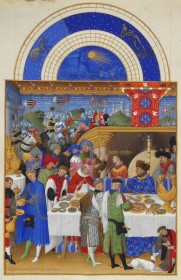The very long period of medieval era last from around AD 400 to AD 1400 and many profound artists emerged from the period, having more knowledge and techniques than the predecessors. Thus, the collective knowledge of the time peaked to its saturation point in 1400. After which the new era of renaissance began taking only the important techniques from the medieval time.
The three medieval artists called Limbourg brothers were born in 1385. That means, they had the privilege to learn from the over a thousand years of cultivation of the arts. So, we can say that they were one of the remarkable artists of the time.
Though, having the knowledge and learning from it are totally different things. But, in Limbourg brothers’ case, they benefited from the collective knowledge, which reflects in their outstanding works. Well, the prematurity and unrealistic presentation of the scenes is because at their times, the idea of using perspective in the paintings was not invented. It was used by renaissance artist like Leonardo da Vinci, Raphael and almost every artist later in 15th and 16th centuries after the idea was conceived in the art.
Harman, Paul and Johan were Dutch artists. At the early years of life, in 1398, their father’s death made them fall under the aegis of their uncle Jean Malouel, who was a prominent artist in the courts. He sent two of them (Harman and Johan) to Paris, where they learned the skill of a goldsmith. When in 1399, they were travelling to Nijmegen; the on-going war in Brussels made them imprisoned. No way to escape and inability of their mother to pay the ransom of 55 escuz made them live in the prison for nearly six months.
Entering in the scene like an angel, Phillip the Bold paid the full ransom and freed them. He took them under his patronage, thus becoming the first patron of the brothers. He commissioned them various works and one of the major works was the commission of illuminated manuscript.
Illuminated manuscripts were the books which also had the decorations such as decorated initials, borders and miniature illustrations. Phillip gave them to illuminate a bible. But the work left unfinished as Phillip died in 1404.
As being miniature artists, Limbourg brothers mainly worked on the illuminated manuscripts and the works which were small in size and can be carried easily anywhere. Because of the size these things (books and miniature portraits) people were able to take them everywhere. That resulted in the spreading those things in many countries. Thus, this spread of the artistic things also spread the art. In a way, the art got international limelight. The style of International Gothic got derived by that expansion of art in many countries. The works of the Limbourg brothers are also categorized in that style.
After the unfinished bible given by Phillip the bold, they worked upon other illuminated manuscripts like Book of Hours (aka Belles Heures du Duc de Berry) and their most famous work known as Très Riches Heures du Duc de Berry. Both were commissioned by the brother of the late Phillip the Bold’s brother John, Duke of Berry. When he got highly satisfied with the first book, he commissioned them even higher task to pursue as the second bible to illustrate.
Though, due to their premature death in 1416, the Tres Riches Heures du Duc de Berry remained unfinished which was allegedly completed by unknown artist of the time.
Like many other artist of the time, plague put an end to their lives around the age of 30. These deaths also closed the chapter of some of the last adept artists of the medieval period.


